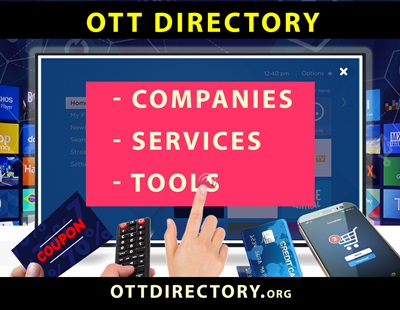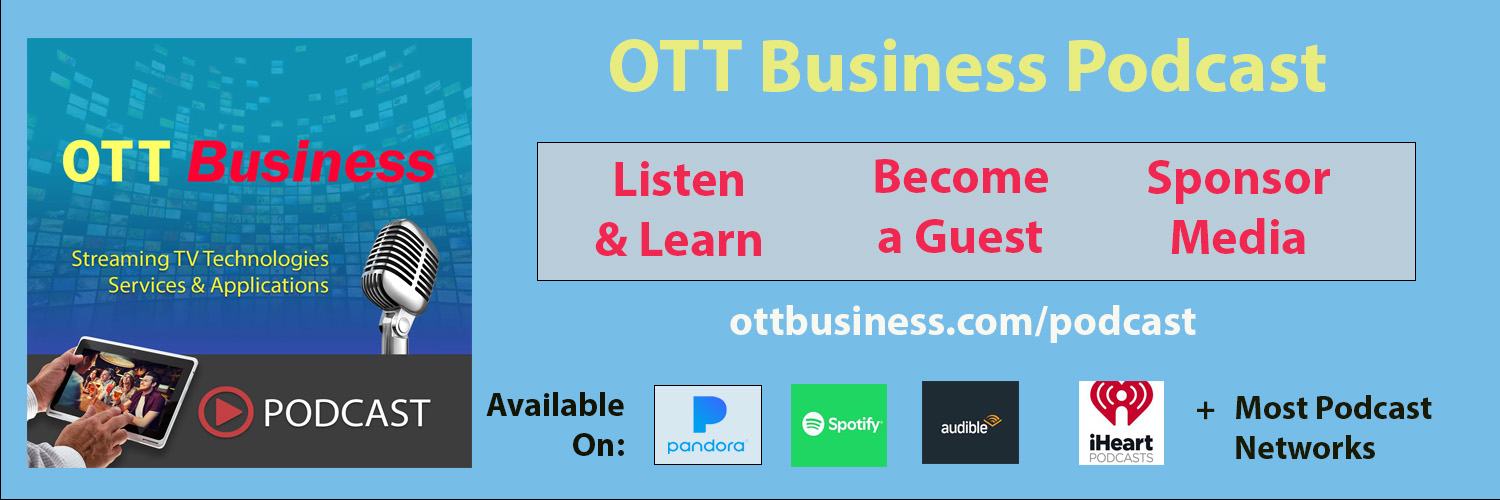OTT Media Distribution Workflow solutions manage and deliver digital content to multiple platforms and devices. Key problems solved by these solutions include ensuring seamless content distribution, optimizing delivery speed, and maintaining security. Essential features such as automated transcoding for multi-format delivery, API integration for workflow customization, and content versioning for tailored regional or platform-specific content help improve efficiency and scale. Additional features like DRM for intellectual property protection, CDN integration for optimized streaming, and real-time analytics enable data-driven decisions that enhance viewer engagement. Learn more about how OTT Media Distribution Workflow solutions can streamline your operations, maximize audience reach, and protect your content assets for long-term success.
OTT Media Distribution Workflow Management

OTT Media Distribution Workflow Management Platforms and Tools List
Accedo – Accedo provides app development and user experience solutions for video services, including tCommerce capabilities for TV shopping.
Allegro DVT – Allegro DVT provides video distribution and workflow automation services, helping OTT platforms efficiently deliver video content to multiple devices.
Amagi – Amagi offers cloud-based media distribution and workflow automation services that simplify content delivery to OTT platforms and traditional TV.
Anevia – Anevia provides OTT and IPTV workflow management and video distribution solutions, enabling OTT platforms to deliver content efficiently.
Arqiva – Arqiva delivers managed media distribution services, enabling broadcasters and OTT platforms to deliver content seamlessly across digital channels and platforms.
Bitmovin – Bitmovin offers cloud-based video encoding and decoding solutions that support multiple codecs, ensuring high-quality streaming for OTT and VOD services.
Brightcove – Brightcove offers video hosting, analytics, and monetization solutions.
ChyronHego – ChyronHego offers media distribution and content workflow solutions for OTT providers to manage and deliver live and on-demand video content.
Cloudinary – Cloudinary offers media management solutions that streamline the upload, storage, transcoding and delivery of video content for OTT services.
Dalet – Dalet provides integrated solutions for media asset management, workflow orchestration, and multiplatform content distribution.
Harmonic – Harmonic VOS offers cloud-based media processing and transcoding solutions for live and on-demand streaming.
Imagine Communications – Imagine Communications delivers IP video monitoring solutions that ensure the reliable transmission and high-quality performance of video streams.
Iomovo – IoMoVo provides an automated cloud-based media management and workflow platform for OTT and Streaming TV service providers.
Kaltura – Kaltura provides an open-source video platform for video management, ad exchange network broadcasting, and delivery.
MediaKind – MediaKind offers media solutions including billing and tCommerce features, enabling seamless interaction and transactions directly through the TV.
Media Tailor – Media Tailor provides advanced content delivery, dynamic ad insertion, audience analytics and monetization optimization tools and services for the OTT and Streaming TV industry.
Mux – Mux provides streaming services, transcoding and API-first platform for video streaming and real-time analytics.
Norsk – Norsk provides real-time video processing solutions that enable OTT and streaming TV platforms to deliver high-performance, low-latency video content to large audiences over the Internet.
Pixotope – Pixotope offers media production and distribution solutions, enabling efficient content workflows for OTT and real-time media distribution.
Platform.sh – Platform.sh provides end-to-end media distribution and content management solutions for OTT platforms to optimize delivery across devices.
Qvest Media – Qvest Media provides workflow management and media distribution solutions for OTT and broadcast platforms, focusing on content delivery and automation.
Signiant – Signiant offers intelligent file transfer and workflow automation solutions designed for fast, secure, and reliable movement of media assets.
Synamedia – Synamedia delivers end-to-end video solutions for OTT service providers, including security, monitoring, and analytics to ensure seamless content delivery.
Telestream – Video transcoding, streaming, and clipping solutions for broadcasting and online media industries.
Vidispine – Vidispine provides workflow automation and media distribution tools to streamline content delivery across OTT platforms and devices.
Vizrt – Vizrt offers a powerful set of tools for real-time 3D graphics, media asset management, and workflow automation to enhance broadcast production.
Vualto – Vualto offers cloud-based DRM and content protection services with real-time tracking and reporting to ensure secure media distribution.
Vubiquity – Provides comprehensive metadata services including EPGs, synopsis, and ratings for enhanced content discovery.
Wurl – Wurl offers cloud-based video distribution solutions, enabling OTT services to distribute content to multiple platforms globally.
Zype – Provides an end-to-end video management, distribution and billing platform for OTT, social media, and digital publishers.
OTT Media Distribution Workflow Management Platforms and Tools Key Features and Capabilities
Analytics and Reporting
This feature provides real-time data on content performance, viewer engagement, and distribution metrics, helping content providers optimize their strategies. By offering valuable insights, it enables data-driven decisions that improve content reach and audience retention, which is critical for maintaining a competitive edge.
API Integration
API integration allows for seamless connectivity with third-party tools and platforms, enhancing workflow customization and automation. This flexibility is important because it enables service providers to adapt the workflow to their specific needs, improving efficiency and scalability.
Automated Transcoding
Automated transcoding efficiently converts video content into multiple formats and resolutions, making it compatible with various platforms and devices. This is essential for ensuring content can be streamed across different devices with optimal quality and user experience.
Content Delivery Network (CDN) Integration
CDN integration ensures faster, more reliable content delivery and optimized streaming performance by distributing media closer to the end user. This is critical for reducing buffering times and ensuring a high-quality viewing experience, especially for large audiences.
Content Ingestion Formats
This feature supports various file formats and resolutions, ensuring easy intake of media from different sources. It is important because it simplifies the content acquisition process, enabling smooth integration from multiple production environments.
Content Scheduling
Content scheduling enables automated or manual scheduling of releases across multiple platforms. This feature is vital for managing time-sensitive releases and maintaining a consistent content flow, improving efficiency and reducing human errors in time management.
Content Versioning
Content versioning provides version control, enabling the management of multiple versions of content, such as localized versions or different edit cuts. This is key for delivering targeted content to specific audiences, regions, or platforms while maintaining a streamlined workflow.
Digital Rights Management (DRM)
DRM tools manage distribution rights, including geo-blocking, to ensure content is delivered only to authorized regions and users. This feature is crucial for protecting intellectual property, maintaining compliance, and preventing unauthorized distribution.
Metadata Management
Metadata management organizes and tags content with accurate metadata for improved searchability, tracking, and compliance. It is essential because it enhances content discoverability and ensures regulatory and contractual obligations are met.
Multi-Platform Distribution
This feature enables seamless delivery of content to a wide range of OTT platforms, apps, and devices, with the ability to manage different distribution channels. This is important for reaching a broader audience and maximizing content visibility across diverse platforms.
Quality Control (QC) Automation
QC automation performs automated checks to ensure that video and audio standards are met before distribution. This feature is crucial for maintaining content quality and ensuring a positive viewing experience, which reduces complaints and enhances brand reputation.
Scalability
Scalability refers to the ability to handle increasing content volumes and distribution demands as the service provider grows. This is vital for accommodating future growth and avoiding disruptions in content delivery as the platform expands.
Security
Security features prevent unauthorized access and piracy, protecting valuable content from being stolen or illegally distributed. This is critical for safeguarding revenue streams and maintaining the integrity of content distribution.
User and Role Management
This feature allows for defining user roles and permissions, controlling access to different parts of the workflow. It is important for ensuring secure management, as it limits access to sensitive areas and prevents unauthorized workflow disruptions.
OTT Media Distribution Workflow Management Platforms and Tools Glossary
Adaptive Bitrate Streaming (ABR) – A technique used in streaming where the video quality automatically adjusts based on the viewer’s internet connection speed, ensuring a smooth viewing experience with minimal buffering.
Application Programming Interface (API) – A set of protocols and tools for building software and applications. In OTT media distribution workflows, API integration enables seamless communication and connectivity between systems, improving automation and customization.
Artificial Intelligence (AI) Integration – The use of AI in media workflows to automate tasks such as content tagging, quality control, and personalized content recommendations, improving efficiency and viewer satisfaction.
Automated Quality Control (QC) – A process that uses software to automatically check video and audio quality, ensuring that content meets the required standards before distribution. This reduces manual errors and ensures a consistent viewing experience.
Automated Transcoding – The process of converting video files into multiple formats and resolutions automatically to ensure compatibility across various platforms and devices. Essential for optimal streaming quality.
Cloud-Based Media Storage – A storage solution where media files are stored in the cloud, allowing easy access, collaboration, and scalability for content distribution.
Compression – The process of reducing the file size of media content without compromising its quality. Essential for efficient streaming and faster content delivery.
Content Delivery Network (CDN) – A system of distributed servers that deliver web content, including media, to users based on their geographic location, improving load times and reducing latency.
Content Ingestion – The process of acquiring and inputting media into the workflow, supporting various file formats and resolutions to streamline integration from multiple production sources.
Content Scheduling – A feature that allows for the automated or manual scheduling of content releases across multiple platforms, ensuring timely delivery and consistent content flow.
Content Versioning – The ability to manage and store different versions of content, such as edits or localized versions, for specific regions or platforms, helping maintain a streamlined workflow.
Digital Media Asset Management (DAM) – A system for organizing, storing, and retrieving media assets such as videos, images, and audio files, making it easier to manage and distribute content efficiently.
Digital Rights Management (DRM) – Tools used to manage and protect content rights, including features like geo-blocking, to ensure content is only accessible to authorized users and regions.
High Efficiency Video Coding (HEVC) – A video compression standard that allows for the transmission of higher-quality video at lower bit rates, improving streaming efficiency and reducing bandwidth usage.
Internet Protocol Television (IPTV) – The delivery of television content over the internet rather than through traditional terrestrial, satellite, or cable formats, often used alongside OTT media workflows.
Live Streaming – The real-time broadcasting of video content over the internet to an audience, requiring efficient workflow management to ensure low latency and high quality across various platforms.
Media Distribution Workflow – The entire process of managing, delivering, and optimizing media content across various platforms, ensuring efficiency, security, and scalability in content distribution.
Metadata Management – The organization and tagging of content with metadata for improved searchability, compliance, and tracking. Crucial for content discoverability and regulatory adherence.
Multi-Platform Distribution – The process of delivering content to multiple OTT platforms, apps, and devices simultaneously, ensuring broad audience reach and maximizing visibility.
Over-The-Top (OTT) Platforms – Services that deliver media content directly to consumers via the internet, bypassing traditional cable and satellite distribution methods.
Real-Time Analytics and Reporting – Tools that provide up-to-the-minute data on content performance, viewer engagement, and distribution metrics, enabling data-driven decisions to optimize content strategies.
Role-Based Access Control (RBAC) – A security feature that defines user roles and permissions within the workflow, limiting access to sensitive content and processes to maintain security.
Scalability – The capability of a workflow system to handle increasing amounts of content and distribution demands as a company grows, ensuring seamless expansion without performance disruptions.
Security – Features designed to prevent unauthorized access, piracy, and illegal distribution of media, safeguarding content integrity and revenue streams.
Server-Side Ad Insertion (SSAI) – A technology that integrates ads into video content on the server side, allowing for seamless ad delivery and reducing buffering during playback.

